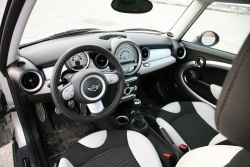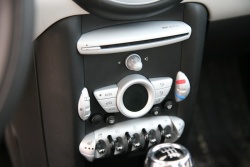   2010 Mini Cooper S. Click image to enlarge |
Some owners say that changing the oil more frequently is a good defense against this issue. Note that timing chain damage or failure can cause severe engine damage. Apparently, a recall campaign was undertaken to address this issue.
Oil consumption may contribute to the timing chain tensioner issue on earlier turbocharged Cooper engines, too. Some owners report heavy oil consumption, others report none, and most debate how much oil consumption is considered ‘normal’.
Apparently, a revised valve cover with redesigned oil-separation passages helped fix some of the oil consumption problem by limiting the amount of oil ‘vapour’ allowed to be ingested back into the intake system via the PCV valve. The jury’s still out on this one – though shoppers should remember that most engines ‘use’ some oil between oil changes, that turbocharged engines tend to ‘use’ a bit more, and that frequent checking of one’s engine oil level and condition is key to long-term engine life.
This is another case for more-frequent-than-advised oil changes as an insurance policy. Running an engine, and especially a turbocharged engine, that’s not-quite-full-enough of dirty oil is a good way to get thunder-punched in the wallet when something fails because of poor lubrication.
Is the Mini you’re considering a convertible? If so, check the area where the roof stores, as well as the vehicle’s carpeting and seats, for signs of moisture damage. Unwelcome moisture can make your convertible smell like a musty gym bag, and can cause rust and mold. Be sure to open and close the top several times, noting any unwelcomed binding, or signs of top motor trouble.
Going with a turbo model? Be sure it’s been treated to frequent, on-time, high-quality oil changes– as these are vital to long-term turbo health. Also, be sure the model you’re considering hasn’t had its turbocharger modified to generate higher boost than the factory intended, as this can damage the turbocharger and other components. A “Turbo Timer”, which lets the engine run a moment or two after being switched off, is a good thing—as it cools the turbocharger down more slowly.
 2007 Mini Cooper. Click image to enlarge |
Signs of a bad turbo include smoke (particularly at idle when the engine is warm), sporadic performance under hard acceleration, and oil leaks out of the turbo housing, possibly into the ‘charge pipes’. Have these removed and check for pools of dirty oil, and also note excessive ‘play’ in the shaft of the turbocharger. Seek a mechanic’s help if you’re not sure how to make these checks. Note that the Mini’s turbocharger is easily accessed since it’s bolted to the front of the engine.
Note that a compression test can be carried out easily on a Cooper to provide a good idea of the engine’s overall health, especially on higher-mileage models.
Check all onboard electronics and switches, confirm proper sunroof operation, and confirm that all power windows and locks are functioning properly.
Premature clutch failure has been reported by many owners, so be sure to drive the manual-equipped Mini you’re considering while ‘feeling’ for signs of slippage or ‘biting back’ from the gearbox while changing gears.
 2007 Mini Cooper. Click image to enlarge |
Bad water pumps, which were addressed by a recall in some countries, may also be an issue—so have a mechanic take a look on a pre-purchase inspection.
A Cooper that’s hard to start, stalls quickly after starting, suffers from poor power output or struggles to maintain idle could be suffering from a High Pressure Fuel Pump (HPFP) that’s about to fail. As the engine computer will likely pick up on this, be sure to have it scanned for stored codes which could indicate problems.
This generation Cooper used Direct Injection, and may suffer the same valve-gunk issues becoming common with this type of engine. Stored ‘misfire’ codes in the engine computer, as well as a rough idle and sporadic performance, or poor results on a compression test, can all indicate the need to open up the engine and ‘de-carbonize’ the tops of the intake valves.
Here is a very useful thread outlining some common issues with this generation Cooper range.
The Verdict: Mini Cooper models from this generation will appeal more largely on fuel efficiency and fun-to-drive factor than low running costs and all-out reliability. Though numerous problems have been reported and documented online, they should be easy for a mechanic at a Mini dealer to diagnose.
For maximum confidence, shop as new a model as your budget will allow in this generation, as improvements were made to address some issues as production went on. Using high-quality engine oil, and changing it more frequently than advised by the owner’s manual, is another great way to protect yourself from potential issues, as is having the engine computer ‘scanned’ for signs of trouble in a few key areas.
Here’s a great candidate for any extended warranty coverage that may be available.
A list of recalls.
Crash Test Results:
National Highway Traffic Safety Administration (NHTSA)
Insurance Institute for Highway Safety (IIHS)











